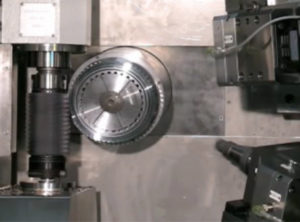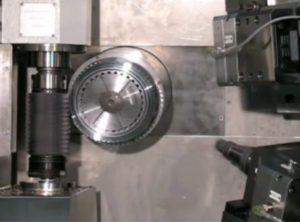Gear making: More from Less
By Scott Knoy, VP of Sales, German Machine Tools of America (GMTA)
When you think of multi-process gear making machinery, you often think of machining centers. These machines are often considered a “jack of all trades and master of none,” where all processe s are completed adequately but not in superior fashion. However, one supplier to the gear making industry, German Machine Tools of America (GMTA) and its parent company, Profilator GmbH, have regularly offered machinery that is able to complete quality, multiple machining operations on one machine tool, for many years.
s are completed adequately but not in superior fashion. However, one supplier to the gear making industry, German Machine Tools of America (GMTA) and its parent company, Profilator GmbH, have regularly offered machinery that is able to complete quality, multiple machining operations on one machine tool, for many years.
The machine configuration utilized is unique to Profilator in the gear industry today, as each cutting operation performed is centered around the company’s established competence in each process.
Combining Processes
Profilator offers the following standard technologies to the gear market today: Gear Scudding®, Gear Hobbing, Gear Tooth Pointing/Rounding, Polygon Generation, Backtaper Cutting, Fly Cutting and Chamfer/Deburring. This machine builder is able to combine the desired processes in a single machine tool to provide the desired results for the customer. The machine configurations available will allow a user to either process a part in a single clamping while cutting multiple features, or cut different features simultaneously on two separate spindles in two different chuckings.
The benefits are obvious for both methods; the increased quality provided by a single clamping can provide a process/part or the speed of simultaneously processed part features or processing multiple parts simultaneously. Whether the customer requires increased speed or accuracy, such machines can address those needs specifically with a “customized standard” solution.
In today’s gear manufacturing world, the thirst for increased quality levels and increased production rates will never be completely quenched. Seen from another perspective, consider this scenario as one where a single machine tool can today produce what was at one time produced on two or three machine tools, with that many setups and clampings creating more possibilities for error, along with substantially longer process times.
Customer costs can be impacted dramatically and will be reduced in one or more of the following ways, by the use of a single machining center to perform multiple operations, reducing idle time, utilizing fewer machines, needing less floor space and/or requiring fewer operators.
Balanced Time
When Scudding® the teeth on a synchronizer ring and then transferring the part to the other spindle for the pointing operation, it is essential that the processing time is balanced on spindle 1 and spindle 2. The Scudding® operation takes 17 seconds and the stock division and pointing takes 17 seconds. Since the machine needs to re-clamp the part in  the second spindle, the machine must stock divide in order to position the part for the pointing operation. This balance is perfectly acceptable and one completed part would therefore be produced every 17 seconds plus load/unload/axial motion time (approximately 27 seconds).
the second spindle, the machine must stock divide in order to position the part for the pointing operation. This balance is perfectly acceptable and one completed part would therefore be produced every 17 seconds plus load/unload/axial motion time (approximately 27 seconds).
Today’s gear processing challenges arise in many forms but are focused mainly on increased quality and increased production speed. As gear manufacturers consider these requirements, they must also consider the classic problems of capacity, floor space, personnel and throughput. Utilizing multiple spindle machinery can help address these issues, while providing cost savings at the same time.
For more information, visit www.gmta



















